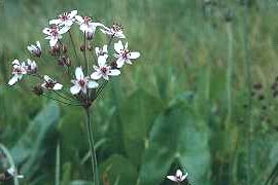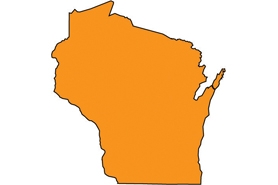Flowering rush
(Butomus umbellatus)
Emergent aquatic perennial that can grow to be 1-5’ tall. It can also survive in water as deep as 10’.
Other names for this plant include:
- Common names: grassy rush, water-gladiolus
Classification in Wisconsin: Restricted
- Ecological Threat
-
- Marshes, backwaters and shorelines; form dense colonies and crowd out native species.
- Identification
-
Leaves: These 3-sided leaves are stiff, narrow and triangular in a cross-section. They get to be 3’ tall and 0.5” wide. They may remain submerged if the water is too deep but are limp.
Flowers: White to light pink rose. Flowers have three petals, three sepals and red anthers. Terminal umbels bloom June-August; rise above leaves. Will not emerge or flower if in deep water.
Fruits & seeds: Clustered follicles with long beaks containing many seeds that are generally not viable.
Roots: Rhizomes that aid in vegetative growth also produce small bulbs, or bulblets, easily dispersed by water.
Similar species: Bur-reed (Sparganium spp.) is another shallow-water emergent roughly the same height as flowering rush and has identical leaves. However, bur-reeds have v-shaped leaves and the female flower parts look like small, spiked balls.
- Distribution
-
See the reported locations of the flowering rush in Wisconsin.
Do you know of other populations? Please send us a report.
- Control
-
Mechanical: Can be cut several times below the water line throughout the year. Small populations can be dug out to get all the root fragments.
Chemical: Some aquatic herbicides may control flowering rush infestations. Aquatic-approved herbicides require a permit.
- Resources
- Sources for content:
- Czarapata, Elizabeth; Invasive Plants of the Upper Midwest: an illustrated guide to their identification and control. The University of Wisconsin Press. 2005. Pg. 142-143


